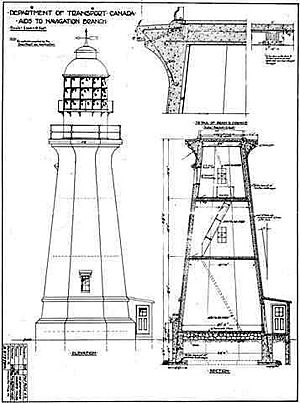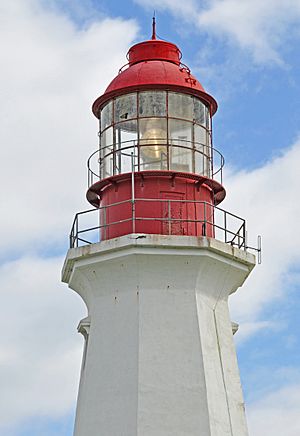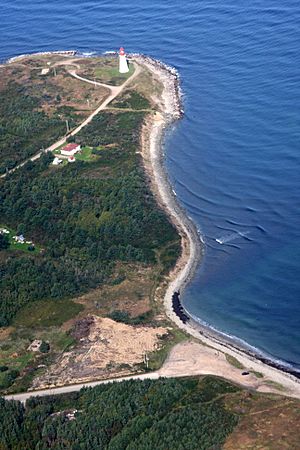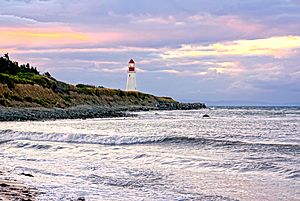Low Point Lighthouse facts for kids
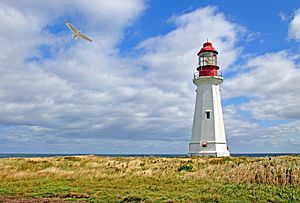 |
|
|
|
|
| Location | New Victoria, Nova Scotia |
|---|---|
| Coordinates | 46°16′01.9″N 60°7′32.9″W / 46.267194°N 60.125806°W |
| Year first constructed | 1832 (first) |
| Year first lit | 1938 (current) |
| Automated | 1988 |
| Construction | concrete tower (current) wooden tower (first) |
| Tower shape | octagonal frustum tower with balcony and lantern |
| Markings / pattern | white tower, red lantern |
| Height | 22 metres (72 ft) |
| Focal height | 26 metres (85 ft) |
| Original lens | third order double bullseye lens |
| Current lens | rotating 36" DCB-36 optic aerobeacon |
| Range | 18 nautical miles (33 km; 21 mi) |
| Characteristic | Fl W 5s. (flash 0.5 sec; eclipse 4.5 sec) Year round. |
| Fog signal | automated horn, two three-second blasts every 60 seconds. |
| Admiralty number | H0758 |
| CHS number | CCG 775 |
| NGA number | 9100 |
| ARLHS number | CAN-287 |
The Low Point Lighthouse (sometimes called 'Flat Point Lighthouse') is a famous Canadian lighthouse. It stands tall at the eastern entrance to Sydney Harbour in New Victoria, Nova Scotia. This lighthouse is one of the oldest and most important in Nova Scotia. It was one of the first dozen lights built to help sailors find their way. Today, this classic red-and-white lighthouse is still used by the Canadian Coast Guard.
Contents
Why is it called Low Point?
This lighthouse is on a low, flat piece of land. This land sticks out about 0.6 kilometres (0.37 mi) into Spanish Bay. People have called this spot both Low Point and Flat Point since at least 1882.
The lighthouse has been listed under both names. Even today, both names are still used by local people. The name was officially approved as Flat Point in 1909. But it was changed to Low Point in 1953.
The First Lighthouse
After 1826, the General Mining Association started shipping much more coal from Sydney Harbour. To help ships, a lighthouse was built at Low Point in 1832. This first lighthouse cost £770.
The first tower was made of wood and had eight sides. It was painted with red and white stripes. It stood 15.54 metres (51.0 ft) tall from its base to the top. During its first winter, a strong storm blew off the lead roof. The light stopped working until a new iron lantern could be put in place.
The lightkeeper, Robert McNab, had a tough time. It was so cold, sometimes minus −25 to −30 degrees Celsius (−13 to −22 degrees Fahrenheit), that he had to put hot coals inside the lantern. This helped keep the poor-quality oil burning. In 1856, McNab complained that the lighthouse and his small home needed many repairs. The light was not strong enough for the busy Sydney Harbour. New lamps were sent, which helped the light. But it took seven more years to get a new, larger iron lantern. This new lantern allowed for bigger oil burners and reflectors.
By 1878, the lantern needed to be even bigger. The tower had to be made stronger to hold it. A temporary light was used while new parts were added. The new iron lantern had 12 sides and was 2.95 metres (9.7 ft) wide. It held 13 burners, each with its own 40.6 centimetres (16.0 in) reflector. The new light started working on July 13, 1878. All the buildings were repaired and painted, making the station look great.
By 1881, Low Point became a signal station. It used the International Code of Signals. It was also one of two stations on Cape Breton Island for the Maritime Telegraph System. During WWI (1917-1918) and WWII, a special Port War Signal Station was located at the Flat Point Lighthouse.
In 1922, a special Fresnel lens was installed. This lens, made in France, flashed white light every five seconds. It replaced the older, steady white light from 1857.
A steam fog-horn was added in 1903. Over the years, many changes were made to the horn and lighting as technology improved. One big problem for the station was erosion. Over time, a lot of money was spent building and fixing walls to protect the land from the sea.
The Lighthouse Today
In 1938, the old wooden tower was replaced. The lighthouse you see today was built then. It is a strong, eight-sided tower made of reinforced concrete. It is painted white and has a few rectangular windows. The base is narrower, and the top widens to hold a platform. On top is a red, dome-shaped iron lantern. This lantern reused the lens and lighting from the old tower. The circular iron lantern housing was built by Chance Brothers, famous makers of lenses and lanterns in England.
In 1953, a new home was built for an assistant keeper. Electricity also came to the station. By 1954, the station had the lighthouse tower, a fog-alarm building, storage buildings, and homes for the head keeper and assistant keeper. The old house was taken down, and its materials were used for other improvements. In 1962, a diaphone horn was added, which needed more machinery. A third lightkeeper was hired, and another home was built for his family.
In 1970, an electronic horn was installed. This meant engines and compressors were no longer needed for the diaphone horn. The third keeper was no longer needed either. His home was sold and moved in 1977. In 1979, the station needed only one person. The older two-story home was first used as a survival station, then sold and moved in 1987. In 1984, the old Fresnel lens was replaced by a DCB-36 optic. This is a 91.44 centimetres (36.00 in) wide rotating airport beacon. The Fresnel lens is now stored at the Coast Guard base in Dartmouth. The round, iron lantern is still on top of the tower. It is the last classic lantern of its kind still used on an active lighthouse in Nova Scotia.
The Low Point Lighthouse stopped having keepers in 1988. However, the newest keeper's house is still there. It is one of the few lighthouse stations that still has its keeper's home. A local non-profit group has restored the house and takes care of it.
Special Recognition
The lighthouse tower is a very important landmark. It is a Recognized Federal Heritage Building. This means it has special historical, architectural, and environmental value. It was given this title on October 19, 2006. It is listed in the Directory of Federal Heritage Designations. This special title only applies to the building itself.
What's Next for the Lighthouse?
Coastal Erosion Concerns
Coastal erosion is a big problem at Low Point. Work to stop the land from washing away started as early as 1915. That year, it cost $3,223.76. By 1917, repairs were already needed, costing another $1,434.06.
By 2015, the lighthouse was only about 20 metres (66 ft) from the cliff edge. It was partly protected by a broken wooden seawall. The land around the tower is washing away, which threatens its base. If a new breakwater isn't built, this large, historic concrete tower could fall into the sea.
No Longer Needed?
The Canadian Coast Guard said in June 2010 that the Low Point Lighthouse was "surplus." This meant it was no longer considered essential for their operations. Many lighthouses across Canada faced the same situation. The lighthouse had until May 29, 2012, to be nominated under the Heritage Lighthouse Protection Act. A group had to agree to take care of it, or the lighthouse might be removed.
Even though it was still working, the Coast Guard thought a simpler structure would be cheaper to run. The Nova Scotia Lighthouse Preservation Society (NSLPS) applied for many lighthouses, including Low Point. They hoped a local group would then take over. By 2012, community groups had asked for 26 Cape Breton lighthouses. But only seven groups submitted the required business plans by the 2013 deadline.
The Low Point Lighthouse Society
Debbie Lee Pearson, who leads the Low Point Lighthouse Society, sent in a business plan in May 2013. The society wants to save the lighthouse.
In 2014, a government official said they had received the plan and community support letters. They would contact the group soon.
In July 2015, the Low Point Lighthouse Society won $75,000. They won an online voting contest to help save lighthouses. This money will be used to fix up the lighthouse and the area around it. The goal is to make it a place for tourists, weddings, and other events.
Debbie Lee Pearson said work was expected to start in spring 2016. The society also wants the lighthouse to be a stop on a new tourist trail around Sydney Harbour. This trail would show off the area's history. They plan to add signs, parking, and information panels. In the future, they hope to have an RV park, campground, gift shop, café, and picnic area.
Pearson said, "We see the lighthouse as a stop on a new Sydney Harbour tourist trail. It could stretch from the Whitney Pier Historical Society Museum, past St. Alphonsus Church, past Fort Petrie and the lighthouse, on to the Colliery Lands Park. Each stop has something special to offer."
The province and the Canadian government have helped pay for studies. One study looked at the existing seawall, costing $3,450. Another studied how to protect the shoreline, costing $7,187. The society thinks rebuilding the seawall will cost about $400,000.
In the fall of 2017, work began on the lighthouse tower itself. Workers removed loose concrete and filled cracks. This helps protect it from winter damage. More work will continue in the spring. The goal is to finish the outside repairs by December 2018.
Lighthouse Keepers
- ??–1856–?? McNab, Robert
- ??
- around 1939–1947 Campbell, "Willie Joe"
- December 1947–1952 Lohnes, Theodore “Ted”
- ??
- 1959–1988 Jobe, James H.
After 1988, the lighthouse became automated.




